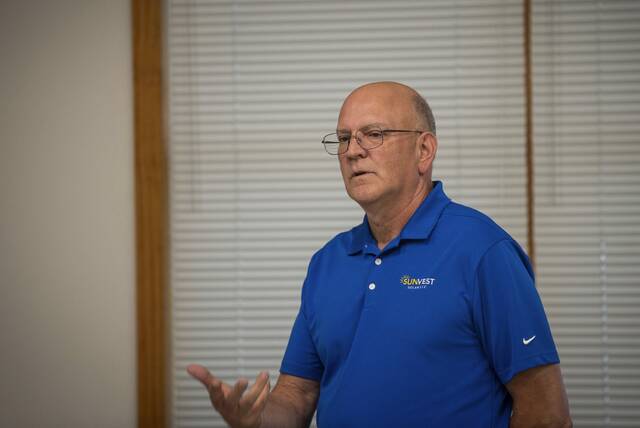https://triblive.com/local/westmoreland/solar-farm-eyed-in-ligonier-township-passes-initial-hurdle-emergency-plans-buffer-required/
Solar farm eyed in Ligonier Township passes initial hurdle; emergency plans, buffer required

Ligonier Township Supervisors unanimously approved a permit for a proposed solar farm on Springer Road on the condition that developer SunVest Solar agrees to plant a buffer and coordinates with first responders on handling any emergencies that may occur at the site.
“This is the first step of many, but this is the most important step,” Bill French, SunVest’s regional director of project development, said following the supervisor’s Tuesday vote to grant the conditional use permit.
“We’re always tickled that there’s a favorable vote,” French said. “Well review all the stipulations and then proceed forward.”
Illinois-based SunVest plans to install a 3-megawatt solar power array on a section of Michael Becer’s farm, about a mile from Ligonier Valley High School. The company has an initial 5-year lease for the 37 acre site, but the solar power system would cover only about 18 acres, French has said.
The electricity it would generate would be sold to area utility FirstEnergy and would be sufficient to power about 450 homes.
There were no objections from the sparse crowd attending Tuesday’s meeting. But Thomas Becer, who lives across the road from the proposed solar site and is a cousin of Michael Becer, argued at the August township planning commission meeting that his property’s value would be ruined because of the view it would have of the array’s solar panels.
The supervisors placed two conditions in SunVest’s permit to address that concern.
The company is required to complete a “viewshed” study and then commit to planting vegetation “to reasonably mitigate the visual impact of the solar project.”
Also, the supervisors stipulated that SunVest must inform them within 20 days of its plan to mitigate any glare the array reflects onto Thomas Becer’s property — if the company’s contention that there will be no such glare turns out to be mistaken.
Other conditions of the permit set forth preparations for potential emergency incidents at the solar farm.
SunVest must provide local firefighters with training for such responses at least every five years during the life of the array.
Signage is required at the site’s locked entry gate with emergency contact information for the site owner and manager. It must include a map of the array’s interior layout, indicate the location of shutoff switches and notify the public of any dangers they may encounter at the property.
Pat McDowell, the township’s emergency management coordinator, said the permit stipulations coincided with his expectations.
“As far as the training goes for the local fire departments, pretty much it’s going to be on an as-needed basis, depending on if we have turnover of personnel,” he said
French has said that the solar system, once in operation, will be monitored from a remote site and can be shut down from the same location if any problems occur. He indicated there is little risk of fire because there will be nothing to burn at the site.
SunVest doesn’t plan to construct any buildings on the property.
Another permit condition calls for a minimum 15-foot -wide space between the solar panels and an 8-foot-tall perimeter security fence. The developer is required to post a bond to cover costs of eventual decommissioning of the array, with the bond amount to be reevaluated every five years.
Some other aspects of the project were noted in a related “findings of fact” document prepared by township Solicitor Dan Hudock and approved by the supervisors.
The array will be reached via a 16-foot-wide access road and will be set back at least 100 feet from Springer Road and from adjoining property lines. There will be between two and four parking spaces inside the fence.
The solar panels will be installed in rows spaced about 20 feet apart.
French said SunVest will need to obtain a number of other permits for the solar project — including or construction of the array and stormwater management. The company also must submit a site development plan.
The planning commission voted 3-1-1 to recommend that the supervisors grant the permit for SunVest, which has proposed the first solar array in the township.
The planning board is expected to consider possible revisions of the township’s solar farm regulations that may reconsider the setback requirement and the zoning districts where such arrays can be permitted. Currently, developers can apply to place solar arrays in the agricultural or industrial districts.
Copyright ©2025— Trib Total Media, LLC (TribLIVE.com)
